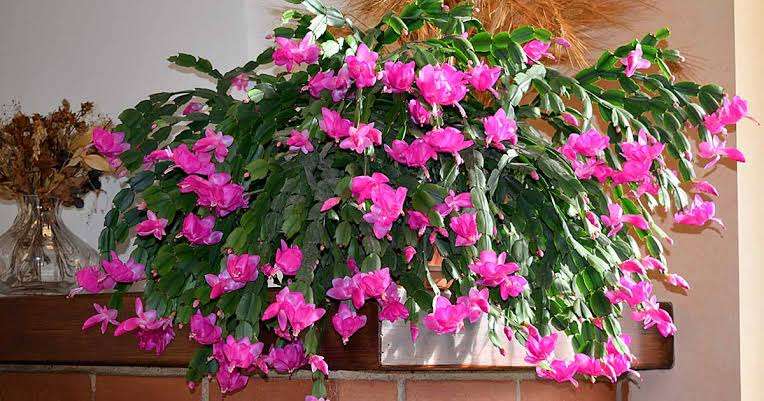
Planting and caring for Christmas Cactus comes with every basic skill and knowledge needed to tend and care for flowery plants. Although, there might be some slight extra required skills for some plants, but then, it all goes to down to how special the plants are.
All the information you need regarding this astonishing houseplant, Christmas Cactus, as to; how to maintain them and the best locations and online e-commerce where you can buy Christmas Cactus are all provided in this article.
Christmas Cactus, most especially can be regarded as some of the very few special plants earlier referred to. Being a family of cactus plants, they are the perfect placement for indoors designs when you need those extra touches of nature in your living room, offices, kitchens etc.
And unlike the usual cactus we often see in desert in pictures, videos, outside offices, homes or gardens, Christmas Cactus does not have the sharp spines of an ordinary desert cactus plant—they are utterly different in both features and presence!
Also Read: Can You Have More Than One Soulmate?
About The Christmas Cactus Plant
What is a Christmas Cactus Called?
What is a Christmas Cactus Called?
Interestingly, these are some of the reasons why you might want to consider buying a Christmas cactus for that family holiday season:
- It is an exotic addition to any indoor settings or designs.
- It propagates easily unlike other flowery plants.
- It’s has bright colours that bring the feelings of nature and garden around your environment.
- It is easy to maintain and root.
- It has long lasting blooms
- It can flower during winter months.
- It can survive for years. Hence, an exquisite item of nature that can define precious moments and memories.
What Does A Christmas Cactus Symbolize?
What Does A Christmas Cactus Symbolize?
However, it’s important to note that the symbolic meaning of a Christmas cactus plant may vary depending on the individual and the context in which it is being viewed.
Types of Christmas Cactus
There are several different types of Christmas cactus, including the following:
Schlumbergera truncata: This is the most common type of Christmas cactus, known for its bright pink or red flowers.
Schlumbergera x buckleyi: This type of Christmas cactus is a hybrid of Schlumbergera truncata and Schlumbergera russelliana, and it produces large, white flowers.
Schlumbergera russelliana: This type of Christmas cactus has pale pink or white flowers and is often called the Easter cactus because it tends to bloom around Easter time.
Schlumbergera opuntioides: This type of Christmas cactus has small, yellow flowers and is native to Brazil.
Rhipsalidopsis gaertneri: This type of Christmas cactus is native to Brazil and has white or pale pink flowers. It is often called the Thanksgiving cactus because it tends to bloom around Thanksgiving.
In short, Christmas Cactus is one of the plants that should come into minds when an exquisite blooming, succulent, flowery plants for indoor settings is being discussed.
Getting the plant rooted in pot is one thing, but caring for and tending the plant is another thing entirely, as the life expectancy of the Christmas cactus heavily depends practically on the plants maintenance and tending.
Fun Fact: It is believed that a Christmas Cactus can survive for decades, and even live up to 200 years of they as long as they are properly tended.
When and How To Plant or Transplant Christmas Cactus
When and How To Plant or Transplant Christmas Cactus
Getting to plant or transplant a Christmas is quite easy, and as well, involves following the same guides and processes. Under this section, you’ll learn when and how to transplant Christmas Cactus and all the prerequisites you’ll be needing.
When To Plant or Transplant Christmas Cactus:
Actually, the best time to plant a Christmas cactus is during the spring or early summer when the soil is warm and moist. The reason for this is due to the fact that it’s a tropical plant that shows more preference to a particular condition.
Planting or transplanting Christmas Cactus during this period allows the plant to establish itself in the pot and develop a strong root system before the arrival of winter.
However, this is not to say that planting a Christmas Cactus any time of the year aside the aforementioned periods would cause it to die or not to bloom, just as long as you provide the right care and conditions.
The following are the guides and the requirements when you are planning to plant or transplant Christmas Cactus:
1. Soil Preference
The first thing you should have if you want to plant/ transplant Christmas Cactus is the soil. You should have a light-weight, free draining soil mixture that is preferably rich in organic matter such as Africa violet mix or cactus mix.
To get this mixture, you can mix equal parts of pear moss, sand and potting soil. On the other hand, you can easily purchase the cactus mix from any nearby garden center.
2. Choosing A Pot
2. Choosing A Pot
Choosing a pot with drainage hole but that not a very large size is also another thing to tick off your checklist. A large pot can hold moisture and can cause the Christmas cactus to rot.
In order to improve the drainage, fill the bottom of the pot with a layer of gravel and add the mixed soil on top of the gravel.
3. Planting/Transplant In The Pot
To plant or transplant Christmas cactus, carefully remove the plant from its original pot and place it gently inside the the new pot. Then, firmly pack and fill the soil mix around the plant and its roots.
4. Watering The Plant
After planting or transplanting christmas cactus, ensure you water it frequently but not excessively. To prevent the over-watering of the cactus, you should wait until the top of the soil has totally dried out before watering it.
As regards different periods or seasons, keep the soil moist but not soggy. And in the winter, reduce frequent watering of the plant.
5. Exposure To Indirect Light
Christmas cacti prefer bright, indirect light. Place your plant near a window that receives bright, filtered light. Avoid direct sunlight, which can scorch the leaves.
If you don’t have a suitable windowsill, you can grow your Christmas cactus under fluorescent lights.
6. Temperature
The temperature of your environment also matters a lot to the growth and flowering of your Christmas Cactus. Generally, they prefer warm and humid conditions, mostly between 65-75°F (18-24°C) during the day and 60-65°F (15-18°C) at night.
7. Proper Fertilization
Proper and regular fertilization is what your Christmas Cactus needs after planting or replanting. You should fertilize it every 2-4 weeks during raining season (April through September).
However, avoid fertilizing it during the winter.
8. Regular Pruning
Christmas cacti can become leggy and unruly if left unpruned. Prune your plant regularly to encourage bushiness and promote new growth. Prune your plant after it has finished flowering to encourage new growth and promote better blooming.
9. Repot The Plant
Repot the Christmas cactus plant every two to three years, using a well-draining cactus soil mix. This will provide the plant with fresh nutrients and help it to grow and thrive
The Christmas Cactus’ Blooms
Christmas Cactus is known for its beautiful and long-lasting blooms. However, many people tend to struggle with getting them to bloom, or booming at the right time.
When Do Christmas Cactus Bloom?: Christmas cactus typically blooms in the late fall or early winter. This is usually the period between October and January. However, the exact timing of the blooms can vary depending on the specific variety, exposure to light, temperature and several other growing conditions mentioned in the previous section.
The blooming process is triggered by sporadic changes in the length of day and night, with the plant responding to shorter days and longer nights by producing blooms.
Getting to set Christmas Cactus to bloom at the required time entails adhering to some details. Under this section, we will discuss the steps you can take to encourage your Christmas cactus to bloom and the reasons why it might not be blooming.
How To Set Christmas Cactus to Bloom:
Christmas cactus is a photoperiodic plant, which development and other responses depends according to the length of the nights and days.
Hence, to encourage Christmas Cactus blooming, you need to create conditions that can actually mimic the natural shortening of days in the fall. Below are some of the steps you can follow to set Christmas cactus to bloom:
1. Reduce Watering
Always reduce the frequency of watering few weeks to the period when you want your Christmas Cactus to bloom. Also, ensure the soil mix is a but dry, but not completely.
2. Reduce Exposure To Light
Place your Christmas Cactus, either in a room with no artificial lights or where it is covered, preferably with a black cloth for 14 hours each day. This should be done a month before the booming takes place.
This process is to allow the us to mimic the shortening of the day length and trigger the blooming process.
3. Increase The Humidity
As a tropical plant, Christmas Cactus prefers humid environments. You can therefore place a tray of water close to the plant or ensure you must the leaves regularly in order to mimic such condition.
Also, ensure the temperature is usually around 60-65°F (15-18°C) during the day and around 55°F (13°C) at night. A cooler temperature will help trigger blooming.
Adhering to this, you can easily set christmas cactus to bloom.
4. Proper Fertilization
Fertilize your Christmas Cactus regularly with balanced liquid fertilizer as this will provide the required nutrients the plant needs to produce blooms.
Going ove this method, you can set christmas cactus to bloom in the right environment and conditions.
Why Christmas Cactus Won’t Bloom
There are several factors or reasons why Christmas cactus might not bloom. Most are just the opposite of what we mentioned earlier.
1. Insufficient or Direct Light
As stated earlier, Christmas cactus needs bright, indirect light to bloom. Insufficient light might cause it not to bloom at the appropriate time.
2. Inconsistency In Temperature
As a tropical plant, Christmas Cactus is sensitive to sporadic changes in temperature. If the irregular temperature fluctuates too much, it can stress the plant and further prevent blooming.
3. Over-Watering
Christmas cactus is sensitive to over-watering. Hence, the need for the draining holes in the pot. Too much of watering can literally causes your Christmas Cactus to root as well as prevent it from blooming.
4. Humidity Environment
A low humid environment can prevent blooming.
5. Lack of Proper Fertilization
Christmas cactus needs regular fertilization to produce blooms. Feed your plant with a balanced fertilizer that can effect its blooming.
6. Over-Pruning
Pruning is undoubtedly essentially to give your Christmas Cactus your desired shape, as well as maintain its growth. However, over-pruning, such as cutting back the stem, can prevent blooming at the required time.
How Often To Water A Christmas Cactus
Christmas Cactus does not require frequent watering. They should only be watered when the soil feels dry to the touch, but at the same time, you shouldn’t allow the soil to dry out completely.
Hence, during the growing season (a period from spring to fall), you should water a Christmas Cactus once a week or when you feel that the soil is too dry. As for the winter season, the plant is usually dormant. As a result, it should be watered once every two or three weeks.
However, the general watering of Christmas Cactus heavily depends on the plant of the size, soil mix and the pot it’s panted in, temperature and many other factors. But it’s usually preferred to water it once a week.
When To Stop Watering Christmas Cactus
You should stop watering your Christmas Cactus plant when the soil is too soggy. Instead, you should wait until the soil dries out a bit before the next watering takes place.
How To Propagate The Christmas Cactus
This plant makes a great holiday gift for friends and family, so knowing how to propagate the Christmas cactus can be beneficial if you don’t want to keep on buying new Christmas Cactus plants.
Propagating the Christmas cactus is a relatively simple process. For a start, take cuttings of one to four segments and let them sit in a cool, dry place for two to four days. After doing this, plant an inch deep in new soil, preferably a sand/peat mix. Water sparingly until roots or new growth develop, then water as normal.
Proper maintenance and care of these segments will cause them to grow into a beautiful Christmas Cactus plants.
Christmas Cactus Where To Buy
There are several places and stores to buy Christmas cactus. Your exact choice depends on your conveniency and it’s availability.
Christmas cactus plants can be purchased at several gardening stores and plant nurseries, as well as supermarkets. You can check with local plant societies or gardening groups to see if they have any Christmas cactus plants available for sale.
You can also order your christmas cactus plants online from a variety of retailers. This is actually better in terms of price and quality comparisons.
Conclusion
In conclusion, Christmas cactus is a beautiful and long-lasting holiday plant, but getting it to bloom can be a challenge. By following the steps outlined above, and understanding the reasons why it might not bloom, you can encourage your Christmas cactus to produce a stunning display of blooms each year.
With proper care and attention, Christmas cactus plant can provide beautiful blooms and add a festive touch to your home during the holiday season and to your environments.


